.
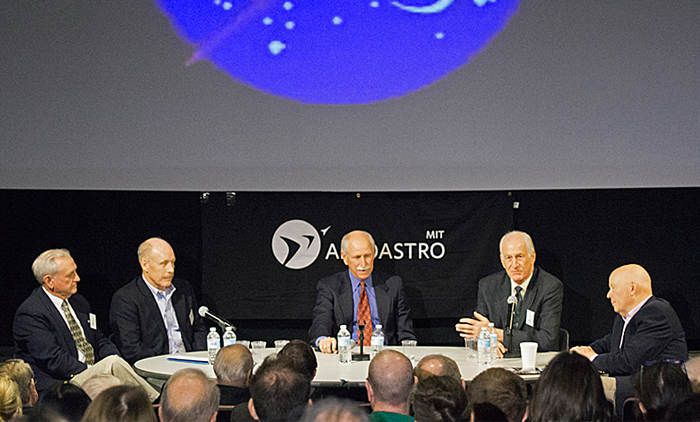
Space Shuttle Endeavour astronauts discussed their 1993 mission to repair the ailing Hubble Space Telescope. From left: mission specialist Tom Akers, pilot Ken Bowersox, mission commander Dick Covey, mission specialist and AeroAstro professor Jeff Hoffman, and payload commander Story Musgrave.
.
Rescuing the Hubble Space Telescope
.
NASA crewmembers reflect on the most complex space repair in history.
.
In the past two decades, the Hubble Space Telescope has produced thousands of staggering images of the universe — capturing colliding galaxies, collapsing stars, and pillars of cosmic gas and dust with its high-precision cameras. These images have driven many scientific discoveries, and have made their way into popular culture, having been featured on album covers, fashion runways, and as backdrops for sci-fi television episodes.
With Hubble’s advanced capabilities today, it’s hard to recall that the telescope was once gravely threatened. But shortly after its launch in 1990, scientists discovered a flaw that jeopardized Hubble’s entire endeavor. What followed was a political and public backlash against the $1 billion mission — and NASA, the agency that oversaw it.
For the next three years, engineers scrambled to design a mission to repair the telescope in space — an ambitious plan that would result in the most complex Space Shuttle mission ever flown.
“[Hubble] was never meant to be a suspense story,” Jeffrey Hoffman, a member of the original astronaut crew charged with repairing the telescope, said this week at MIT. Nevertheless, at the time, the future of Hubble — and of NASA itself — seemed to hinge on the repair mission.
On Dec. 2, 1993, Hoffman and six other astronauts aboard Space Shuttle Endeavour began an 11-day mission, named STS-61, that involved five spacewalks — the most of any shuttle mission — to restore Hubble’s vision.
This week, Hoffman, now a professor of the practice in MIT’s Department of Aeronautics and Astronautics, was joined by other members of the STS-61 crew in reflecting on Hubble’s rescue mission in an all-day symposium held in MIT’s Bartos Theatre. Talks and panel discussions — often with the air of a warm reunion — explored Hubble’s initial promise; its failure shortly after launch; and the planning, training, and execution of a rescue mission to fix the telescope.
.
Hubble’s backlash
.
The first inkling of a problem came during a NASA press conference held to present the first image taken by Hubble from space: The image, of a far-off star, appeared fuzzy. Scientists soon discovered a “spherical aberration”: Due to a defect in the manufacturing process, the telescope’s primary mirror had been ground too flat, setting its curvature off by less than the width of a hair.
“The unthinkable had become fact,” said James Crocker, then an optical engineer at NASA.
Once word of the defect spread, Hoffman recalled that NASA and the astronomy community experienced “a maelstrom of public opprobrium,” mainly circling around the same question: “How did you screw up so badly?”
To illustrate the public feeling at the time, John Logsdon, former director of the Space Policy Center at George Washington University, presented editorial cartoons deriding the mission with pictures of lemons in space and images of static, “courtesy of the Amazing Hubble Telescope.” Overall, Logsdon observed, public perception of the problem focused less on the defects in space than on the agency on the ground.
“NASA was very much at risk,” Logsdon said.
.
Preparing a fix
.
Following the discovery of Hubble’s defective mirror, engineers at NASA faced immense pressure to fix the problem. Crocker eventually experienced what he called a “eureka moment” in the most unlikely of places: a shower in Munich, where he had traveled to appeal to the European Space Agency for possible solutions. On a break in his hotel room, he was adjusting the showerhead — a European design that extends or retracts to accommodate one’s height — when an idea came to him: Why not outfit Hubble with corrected mirrors built on robotic arms that can extend into the telescope and retract into place, just like an adjustable showerhead?
NASA engineers ran with the idea, building the Wide Field and Planetary Camera 2, or WFPC2, to replace Hubble’s defective mirror. Getting the piano-sized instrument into the satellite required 11 months of training by Hoffman and six other astronauts, who spent more than 230 hours in a water tank, choreographing intricate maneuvers and learning to use more than 150 tools. Meanwhile, engineers tested and retested the instruments to be installed on the telescope.
Frank Cepollina, then NASA’s manager of space servicing capabilities, remembers that at the time there was “great turmoil in checking every socket and bolt.”
.
A spacewalk to save NASA
.
All preparations led up to Dec. 2, 1993, when the STS-61 crew launched. On the mission’s third day, the crew used the shuttle’s robotic arm to grab hold of the free-floating telescope, attaching it to the shuttle’s cargo bay, an event that prompted mission commander Dick Covey to announce: “We’ve got a firm handshake with Mr. Hubble’s telescope.”
The next day, Hoffman and payload commander Story Musgrave embarked on the mission’s first spacewalk, during which Hoffman, anchored to the robotic arm, replaced two gyroscopes on the telescope.
Astronauts Kathryn Thornton and Thomas Akers set out on the second spacewalk to replace one of the telescope’s solar panels, which had begun to list. After the astronauts disengaged the panel from the telescope, Hoffman remembers watching the array drift off into space, “like some prehistoric bird floating away — we were mesmerized.”
Hoffman and Musgrave performed the mission’s third spacewalk to swap out Hubble’s defective mirror with the 620-pound WFPC2 — the crux of the mission, and one that saw Hoffman anchored to the robotic arm, with Musgrave free-floating inside the telescope as Hoffman fed tools to him.
“It was a little like working under a car,” recalled Hoffman, who said the procedure was so complex that the shuttle crew had to talk them through each step. The procedure was a success, as NASA’s ground controllers found that the new mirror passed all its initial tests.
The remainder of the mission went largely according to plan, except for one hair-raising moment on the final spacewalk. On his previous outing, Hoffman had noticed that Hubble’s magnetometers, located at the very tip of the telescope, were flaking. To prevent more debris from possibly damaging equipment, pilot Kenneth Bowersox and mission specialist Claude Nicollier fabricated makeshift covers out of insulation to wrap around new magnetometers.
During the fifth and final spacewalk, Hoffman and Musgrave replaced the telescope’s magnetometers with the insulated upgrades, a maneuver that required removing screws and placing them in a bag while removing one instrument. In the process, a screw got away, floating free of the astronauts’ grasp. While seemingly harmless, the 3-millimeter screw had the potential to dent the telescope or the shuttle.
Hoffman, anchored to the shuttle’s arm, reached in vain for the screw, while Nicollier tried moving the arm farther out. But both the arm and the screw were moving at the same speed. In a spur-of-the-moment action, Bowersox reprogrammed the shuttle’s computer to reset the arm’s maximum speed, allowing Hoffman to reach the screw. From then on, the astronauts would refer to the escapade as “the Great Screw Chase.”
.
Continuing success
.
Since that first repair mission, astronomers have used Hubble to collect thousands of stunning images of the universe and make countless discoveries, with more than 11,000 published papers based on Hubble images. The telescope has undergone four more servicing missions to replace old instruments and add new capabilities.
Of Hubble’s future, Cepollina said: “As long as the telescope can collect photons, and we can provide next-generation instruments, we should keep truckin’.”
For the astronauts who rescued Hubble, disengagement from the telescope was bittersweet.
“It was a little sad to let the telescope go,” Bowersox recalled. “It was like saying goodbye to a friend. It was a great, magical time.”
.
Quelle: Massachusetts Institute of Technology (MIT)
.
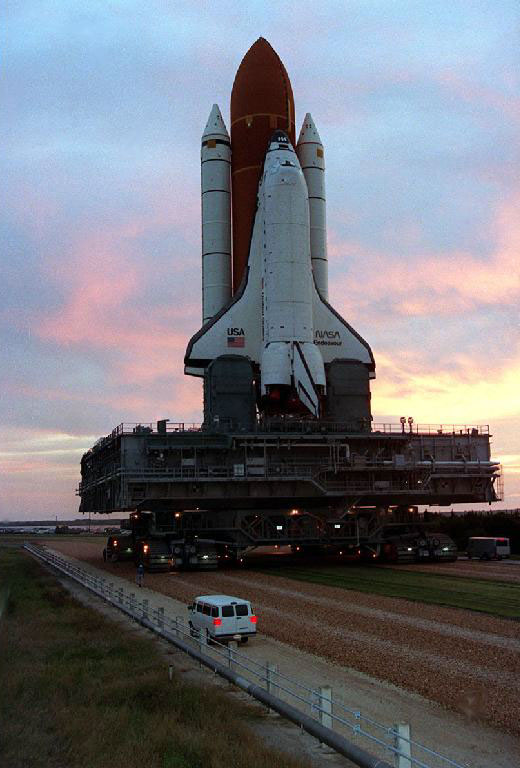
Endeavour Heads to Launch Pad
A morning sky drenched in vibrant color welcomes the Space Shuttle Endeavour as it rolls out to Launch Pad 39A today. Endeavour is being readied for the STS-61 mission, targeted for liftoff in early December. During the 11-day flight, a seven-member crew will carry out the first servicing of the Hubble Space Telescope.
-

Endeavour Changes Launch Pads
The Space Shuttle Endeavour is being rolled around from Launch Pad 39A to Launch Pad 39B. The rare pad switch was deemed necessary after contamination was discovered in the Payload Changeout Room at Pad A. The transfer began around noon and was completed about seven hours later. Still to come are the payloads for the upcoming STS-61 mission, the first servicing of the Hubble Space Telescope.
.
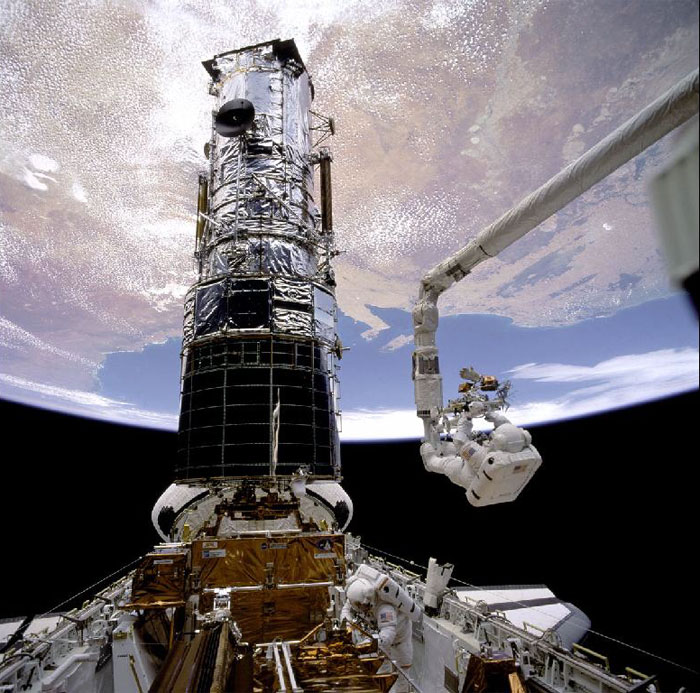
Hubble's Repair Team Gets to Work
Astronaut F. Story Musgrave, anchored on the end of the Remote Manipulator System (RMS) arm, prepares to be elevated to the top of the Hubble Space Telescope (HST) to install protective covers on the magnetometers. Astronaut Jeffrey A. Hoffman inside payload bay, assisted Musgrave with final servicing tasks on the telescope, wrapping up five days of space walks.
.

STS061-87-062 (5 Dec. 1993) --- Astronaut F. Story Musgrave (top right center) works with a restraint device near the Hubble Space Telescope (HST) during the first of five STS-61 extravehicular activities (EVA). Astronaut Jeffrey A. Hoffman, who joined Musgrave for three of the five spacewalks, is seen at the bottom of the frame preparing to work with fuse plugs. Photo credit: NASA
.
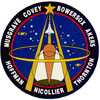
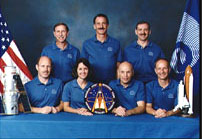
STS-61 Crew photo with Commander Richard O. Covey, Pilot Kenneth D. Bowersox, Payload Commander F. Story Musgrave and Mission Specialists Kathryn C. Thornton, Claude Nicollier, Jeffrey A. Hoffman and Tom Akers.
.
Launch originally scheduled to occur from Launch Pad 39A, but after rollout, contamination was found in the Pad 39A Payload Changeout Room and a decision was made to move the shuttle and payloads to Pad 39B. Rollaround occurred on Nov. 15. The first launch attempt on Dec. 1 was scrubbed due to out-of-limit weather conditions at the Shuttle Landing Facility in the event of a return-to-launch-site contingency. Launch on Dec. 2 occurred on schedule.
Mission Highlights
.
The final shuttle flight of 1993 was one of most challenging and complex manned missions ever attempted. During a record five back-to-back space walks totaling 35 hours and 28 minutes, two teams of astronauts completed the first servicing of the Hubble Space Telescope (HST). In many instances, tasks were completed sooner than expected and a few contingencies that did arise were handled smoothly.
Hubble rendezvous, grapple and berthing occurred on flight day three, with Nicollier using the remote manipulator system arm to position the 43-foot (13-meter) long Hubble upright in payload bay. Throughout mission, commands to Hubble issued from Space Telescope Operations Control Center (STOCC) at Goddard Space Flight Center. After each servicing task completed, STOCC controllers verified electrical interfaces between replacement hardware and telescope.
On flight day four, first EVA team of Musgrave and Hoffman performed EVA #1, replacing two Rate Sensing Units (RSUs), each housing pair of gyroscopes; two Electronic Control Units which direct the RSUs; and eight electrical fuse plugs. Only unexpected problem occurred when Hoffman and Musgrave had difficulty closing compartment doors after replacing RSUs. Seven-hour, 54-minute space walk second longest in U.S. history to date, topped only by STS-49 EVA lasting eight hours, 29 minutes. During EVAs, Nicollier operated robot arm carrying one of two EVA crew members.
One of primary servicing goals -- installation of new solar arrays -- accomplished during EVA #2, performed on flight day five by Thornton and Akers and lasting six hours, 35 minutes. Timeline was re-worked to accommodate jettison of one of two original solar arrays, which could not be fully retracted due to kink in framework. Other solar array stowed in payload bay and replacement pair -- set of modified spares -- were installed without difficulty.
Expected four-hour replacement of one of Hubble's five scientific instruments, Wide Field/Planetary Camera (WF/PC), completed in about 40 minutes by Hoffman and Musgrave during EVA #3 on flight day six. WF/PC II is upgraded spare modified to compensate for flaw in HST primary mirror. Also, two new magnetometers installed at top of telescope during the six-hour, 48-minute EVA.
EVA #4 performed on flight day seven by Thornton and Akers. High-Speed Photometer, one of Hubble scientific instruments, removed and replaced with Corrective Optics Space Telescope Axial Replacement (COSTAR) unit. Task took less time to complete than expected. COSTAR designed to redirect light to three of four remaining Hubble instruments to compensate for flaw in primary mirror of telescope. Thornton and Akers also installed co-processor to enhance memory and speed of Hubble computer. During six-hour, 50- minute EVA, Akers set new U.S. space-walking record of 29 hours, 39 minutes, topping Eugene Cernan's 20-year-old record of 24 hours, 14 minutes. Thornton is leading U.S. female space walker with total of 21 hours, 10 minutes.
Final EVA performed by Hoffman and Musgrave on flight day eight. During seven-hour, 21-minute-long EVA #5, Hoffman and Musgrave replaced Solar Array Drive Electronics (SADE) unit and installed Goddard High Resolution Spectrograph Redundancy (GHRS) kit; also installed two protective covers over original magnetometers. After space walk completed, the new solar arrays and two high-gain antennas were deployed by STOCC. HST was also re-boosted to a slightly higher orbit of 321 nautical miles (595 kilometers) on flight day eight prior to the last EVA.
Hubble was redeployed on flight day nine. Release was delayed several hours to allow troubleshooting of erratic data telemetry from Hubble subsystems monitor; problem had occurred before and was not related to servicing. President Clinton and Vice President Gore congratulated crew, and Swiss minister of internal affairs called the following day to congratulate Nicollier.
.
Quelle: NASA
5427 Views
